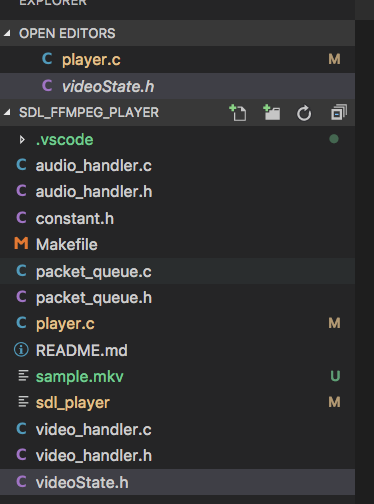阅读LXH《FFMPEG+SDL的视频播放器》总结
一、原文地址
https://blog.csdn.net/leixiaohua1020/article/details/46889389
在此向雷霄骅致敬!!!
二、视频播放器实现思路
1)视频播放器大致可分为,视频文件IO模块,解复用模块,音视频解码模块,视频渲染模块,音频播放模块
2)ffmpeg中的代码可以实现上面所有的内容,但是为了手工实现一个播放器,上面的项目中只用ffmpeg来读取视频文件和解码视频文件
3)SDL是一个主要用于游戏领域的跨平台音视频渲染库,上面的项目中使用SDL渲染解码之后的YUV图像
三、项目代码分析
文件目录:

核心代码:
typedef struct VideoState {
AVFormatContext *pFormatCtx;
int videoStream, audioStream;
AVStream *audio_st;
PacketQueue audioq;
uint8_t audio_buf[(MAX_AUDIO_FRAME_SIZE * 3) / 2];
unsigned int audio_buf_size;
unsigned int audio_buf_index;
AVFrame audio_frame;
AVPacket audio_pkt;
uint8_t *audio_pkt_data;
int audio_pkt_size;
AVStream *video_st;
PacketQueue videoq;
VideoPicture pictq[VIDEO_PICTURE_QUEUE_SIZE];
int pictq_size, pictq_rindex, pictq_windex;
//picture原子保护
SDL_mutex *pictq_mutex;
SDL_cond *pictq_cond;
SDL_Thread *parse_tid;
SDL_Thread *video_tid;
char filename[1024];
int quit;
AVIOContext *io_context;
struct SwsContext *sws_ctx;
double video_clock;
double audio_clock;
double frame_last_delay;
double frame_last_pts;
double frame_timer;
} VideoState;
上面的结构体包含了播放器中共有的核心对象,整个程序中都会使用到,是整个播放器的上下文
可以看到里面包含两个队列,一个是视频队列,一个音频队列;看一下队列的实现:
typedef struct PacketQueue {
AVPacketList *first_pkt, *last_pkt;
int nb_packets;
int size;
//保持队列的原子性
SDL_mutex *mutex;
//put get 操作通信
SDL_cond *cond;
} PacketQueue;
队列的定义中包含一个临界区锁和一个信号量,这个保证了队列的存取多线程的安全性,实现如下:
int packet_queue_put(PacketQueue *q, AVPacket *pkt) {
AVPacketList *pkt1;
if(av_dup_packet(pkt) < 0) {
return -1;
}
pkt1 = (AVPacketList*)av_malloc(sizeof(AVPacketList));
if (!pkt1)
return -1;
pkt1->pkt = *pkt;
pkt1->next = NULL;
SDL_LockMutex(q->mutex);
if (!q->last_pkt)
q->first_pkt = pkt1;
else
q->last_pkt->next = pkt1;
q->last_pkt = pkt1;
q->nb_packets++;
q->size += pkt1->pkt.size;
SDL_CondSignal(q->cond);
SDL_UnlockMutex(q->mutex);
return 0;
}
int packet_queue_get(PacketQueue *q, AVPacket *pkt, int block)
{
AVPacketList *pkt1;
int ret;
SDL_LockMutex(q->mutex);
while(1){
if(global_video_state->quit) {
ret = -1;
break;
}
pkt1 = q->first_pkt;
if (pkt1) {
q->first_pkt = pkt1->next;
if (!q->first_pkt)
q->last_pkt = NULL;
q->nb_packets--;
q->size -= pkt1->pkt.size;
*pkt = pkt1->pkt;
av_free(pkt1);
ret = 1;
break;
} else if (!block) {
ret = 0;
break;
} else {
SDL_CondWait(q->cond, q->mutex);
}
}
SDL_UnlockMutex(q->mutex);
return ret;
}
多线程访问这个队列的时候,可以较好的实现数据之间的同步。
main入口函数分析:
int main(int argc, char *argv[])
{
SDL_Event event;
VideoState *is;
is = (VideoState*)av_mallocz(sizeof(VideoState));
global_video_state = is;
if(argc < 2) {
fprintf(stderr, "Usage: test <file>\n");
exit(1);
}
// Register all formats and codecs
av_register_all();
avformat_network_init();
if(SDL_Init(SDL_INIT_VIDEO | SDL_INIT_AUDIO | SDL_INIT_TIMER)) {
fprintf(stderr, "Could not initialize SDL - %s\n", SDL_GetError());
exit(1);
}
// Make a screen to put our video
screen = SDL_SetVideoMode(640, 480, 0, 0);
if(!screen) {
fprintf(stderr, "SDL: could not set video mode - exiting\n");
exit(1);
}
av_strlcpy(is->filename, argv[1], 1024);
is->pictq_mutex = SDL_CreateMutex();
is->pictq_cond = SDL_CreateCond();
schedule_refresh(is, 40);
is->parse_tid = SDL_CreateThread(decode_thread, is);
if(!is->parse_tid) {
av_free(is);
return -1;
}
while(1){
SDL_WaitEvent(&event);
switch(event.type) {
case FF_QUIT_EVENT:
case SDL_QUIT:
is->quit = 1;
/*
* If the video has finished playing, then both the picture and
* audio queues are waiting for more data. Make them stop
* waiting and terminate normally.
*/
SDL_CondSignal(is->audioq.cond);
SDL_CondSignal(is->videoq.cond);
SDL_Quit();
return 0;
break;
case FF_ALLOC_EVENT:
alloc_picture(event.user.data1);
break;
case FF_REFRESH_EVENT:
video_refresh_timer(event.user.data1);
break;
default:
break;
}
}
return 0;
}
先看上面两行加粗的代码
第一行初始化音频、视频、定时器模块;这里是SDL初始化的代码,以上都是SDL初始化相关内容
第二行是真正的入口,创建一个解码线程,在解码线程中同时创建视频渲染线程
int stream_component_open(VideoState *is, int stream_index)
{
AVFormatContext *pFormatCtx = is->pFormatCtx;
AVCodecContext *codecCtx = NULL;
AVCodec *codec = NULL;
AVDictionary *optionsDict = NULL;
SDL_AudioSpec wanted_spec, spec;
if(stream_index < 0 || (unsigned int)stream_index >= pFormatCtx->nb_streams) {
return -1;
}
// Get a pointer to the codec context for the video stream
codecCtx = pFormatCtx->streams[stream_index]->codec;
if(codecCtx->codec_type == AVMEDIA_TYPE_AUDIO) {
// Set audio settings from codec info
wanted_spec.freq = codecCtx->sample_rate;
wanted_spec.format = AUDIO_S16SYS;
wanted_spec.channels = codecCtx->channels;
wanted_spec.silence = 0;
wanted_spec.samples = SDL_AUDIO_BUFFER_SIZE;
wanted_spec.callback = audio_callback;
wanted_spec.userdata = is;
if(SDL_OpenAudio(&wanted_spec, &spec) < 0) {
fprintf(stderr, "SDL_OpenAudio: %s\n", SDL_GetError());
return -1;
}
}
codec = avcodec_find_decoder(codecCtx->codec_id);
if(!codec || (avcodec_open2(codecCtx, codec, &optionsDict) < 0)) {
fprintf(stderr, "Unsupported codec!\n");
return -1;
};
wanted_spec.callback = audio_callback;
switch(codecCtx->codec_type) {
case AVMEDIA_TYPE_AUDIO:
is->audioStream = stream_index;
is->audio_st = pFormatCtx->streams[stream_index];
is->audio_buf_size = 0;
is->audio_buf_index = 0;
memset(&is->audio_pkt, 0, sizeof(is->audio_pkt));
packet_queue_init(&is->audioq);
SDL_PauseAudio(0);
break;
case AVMEDIA_TYPE_VIDEO:
is->videoStream = stream_index;
is->frame_timer = (double)av_gettime() / 1000000.0;
is->video_st = pFormatCtx->streams[stream_index];
packet_queue_init(&is->videoq);
is->video_tid = SDL_CreateThread(video_thread, is);
is->sws_ctx =
sws_getContext
(
is->video_st->codec->width,
is->video_st->codec->height,
is->video_st->codec->pix_fmt,
is->video_st->codec->width,
is->video_st->codec->height,
AV_PIX_FMT_YUV420P,
SWS_BILINEAR,
0,
0,
0
);
/* codecCtx->get_buffer2 = our_get_buffer; */
break;
default:
break;
}
return 0;
}
那现在解码线程+渲染线程都有了;他们之间的信息(task)是如何传递的呢?
就是刚才全局上下文中的音频和视频队列;
这个队列实现很精妙,在队列满的时候会导致生产者阻塞,在队列空的时候会导致消费者阻塞,如此一来,在播放器因为网络差的时候得不到视频文件,因此队列为空,后续所有的任务自动“暂停”
while(1){
if(is->quit) {
break;
}
// seek stuff goes here
if(is->audioq.size > MAX_AUDIOQ_SIZE ||
is->videoq.size > MAX_VIDEOQ_SIZE) {
SDL_Delay(10);
continue;
}
队列满的时候,停止放数据到队列中;
int queue_picture(VideoState *is, AVFrame *pFrame,double pts)
{
VideoPicture *vp;
AVPicture pict;
/* wait until we have space for a new pic */
SDL_LockMutex(is->pictq_mutex);
//最大显示缓存队列已蛮,等待信号
while(is->pictq_size >= VIDEO_PICTURE_QUEUE_SIZE &&
!is->quit) {
SDL_CondWait(is->pictq_cond, is->pictq_mutex);
}
SDL_UnlockMutex(is->pictq_mutex);
if(is->quit)
return -1;
同时在放数据的业务层,也判断一下自定义的缓冲区大小,如果满了就阻塞,等待队列释放空间,这样能精确控制内存
更精妙的是,在解码一帧图像的时候,这里利用信号和锁+SDL事件队列,方便控制了一帧图像的渲染;因为这张渲染的bmp是全局共享的,同样需要保证线程安全
if(!vp->bmp ||
vp->width != is->video_st->codec->width ||
vp->height != is->video_st->codec->height) {
SDL_Event event;
vp->allocated = 0;
/* we have to do it in the main thread */
event.type = FF_ALLOC_EVENT;
event.user.data1 = is;
SDL_PushEvent(&event);
/* wait until we have a picture allocated */
SDL_LockMutex(is->pictq_mutex);
while(!vp->allocated && !is->quit) {
SDL_CondWait(is->pictq_cond, is->pictq_mutex);
}
SDL_UnlockMutex(is->pictq_mutex);
if(is->quit) {
return -1;
}
}
借助上面的思路可以完全实现内存的上限控制,限制队列的大小就可以实现,这样在嵌入式设备上面可以精确控制内存的使用。
四、音视频同步
void video_refresh_timer(void *userdata) {
VideoState *is = (VideoState *)userdata;
VideoPicture *vp;
double actual_delay, delay, sync_threshold, ref_clock, diff;
if(is->video_st) {
if(is->pictq_size == 0) {
schedule_refresh(is, 1);
} else {
/* printf("vidoe clock %f audio clock %f \n",is->video_clock,is->audio_clock); */
/* printf("audio clock %f",is->audio_clock); */
vp = &is->pictq[is->pictq_rindex];
delay = vp->pts - is->frame_last_pts; /* the pts from last time */
/* printf("delay %f ",delay); */
if(delay <= 0 || delay >= 1.0) {
/* if incorrect delay, use previous one */
delay = is->frame_last_delay;
}
/* save for next time */
is->frame_last_delay = delay;
is->frame_last_pts = vp->pts;
/* update delay to sync to audio */
ref_clock = get_audio_clock(is);
diff = vp->pts - ref_clock;
/* printf("diff %f \n",diff); */
/* Skip or repeat the frame. Take delay into account
FFPlay still doesn't "know if this is the best guess." */
sync_threshold = (delay > AV_SYNC_THRESHOLD) ? delay : AV_SYNC_THRESHOLD;
if(fabs(diff) < AV_NOSYNC_THRESHOLD) {
if(diff <= -sync_threshold) {
delay = 0;
} else if(diff >= sync_threshold) {
delay = 2 * delay;
}
}
is->frame_timer += delay;
/* computer the REAL delay */
actual_delay = is->frame_timer - (av_gettime() / 1000000.0);
/* printf("diff %f actual delay %f \n",diff,actual_delay); */
if(actual_delay < 0.010) {
/* Really it should skip the picture instead */
actual_delay = 0.010;
}
schedule_refresh(is, (int)(actual_delay * 1000 + 0.5));
/* show the picture! */
video_display(is);
/* update queue for next picture! */
if(++is->pictq_rindex == VIDEO_PICTURE_QUEUE_SIZE) {
is->pictq_rindex = 0;
}
SDL_LockMutex(is->pictq_mutex);
is->pictq_size--;
SDL_CondSignal(is->pictq_cond);
SDL_UnlockMutex(is->pictq_mutex);
}
} else {
schedule_refresh(is, 100);
}
}
利用SDL的timer模块,我们每次注册一个timer,渲染完一帧图像之后,根据pts,当前的clock,音频的clock设置下一帧渲染的timer
这样可以实现视频的连续刷新



 浙公网安备 33010602011771号
浙公网安备 33010602011771号